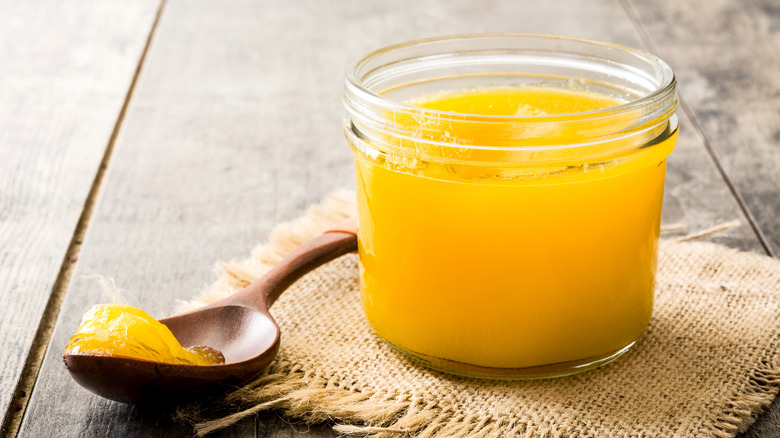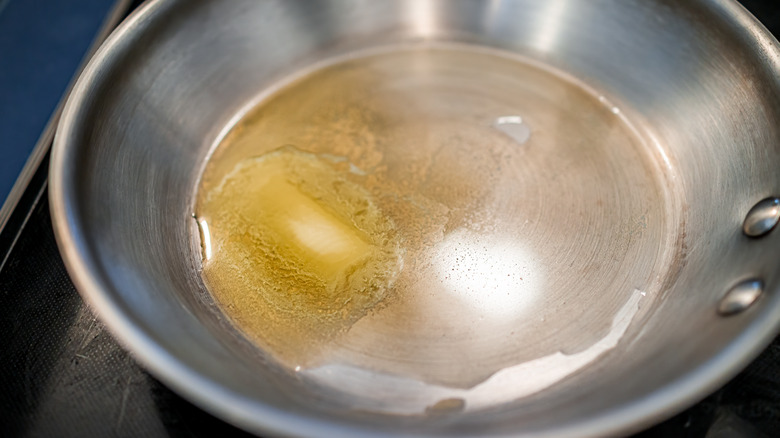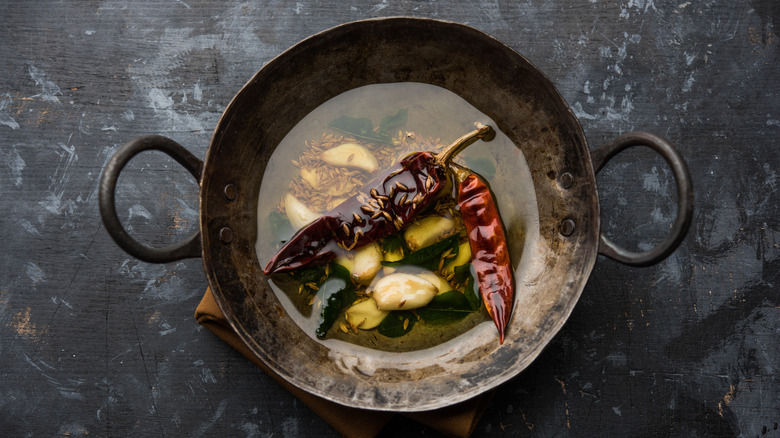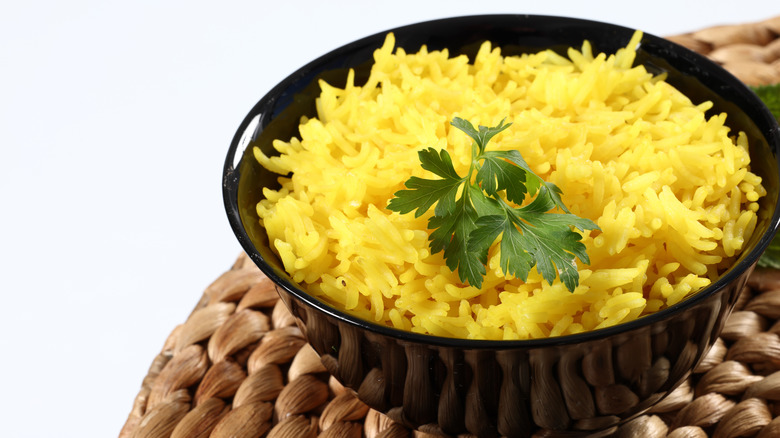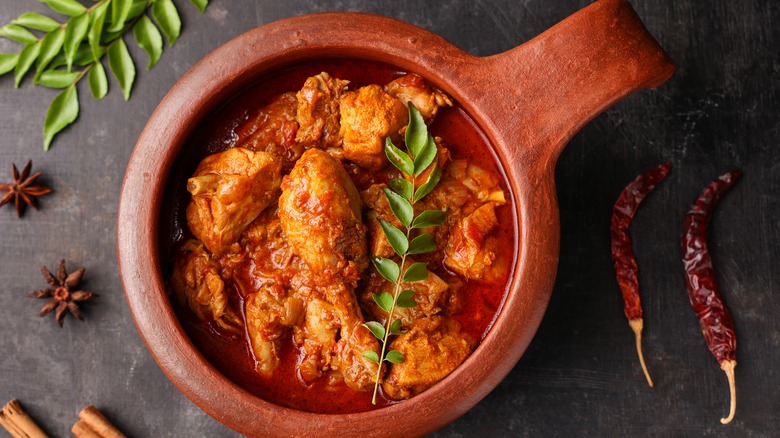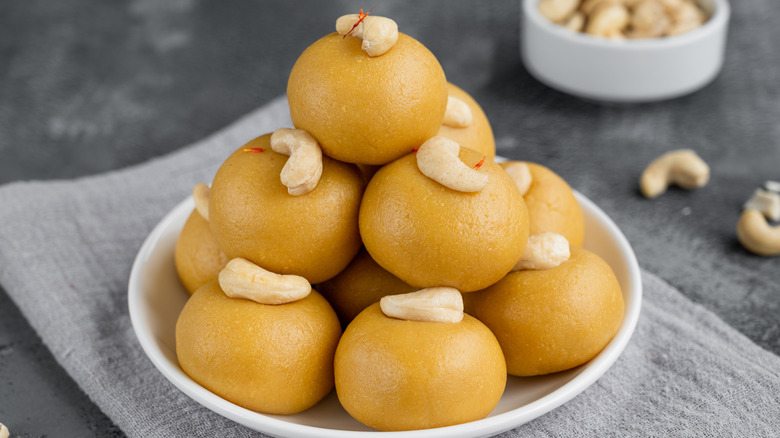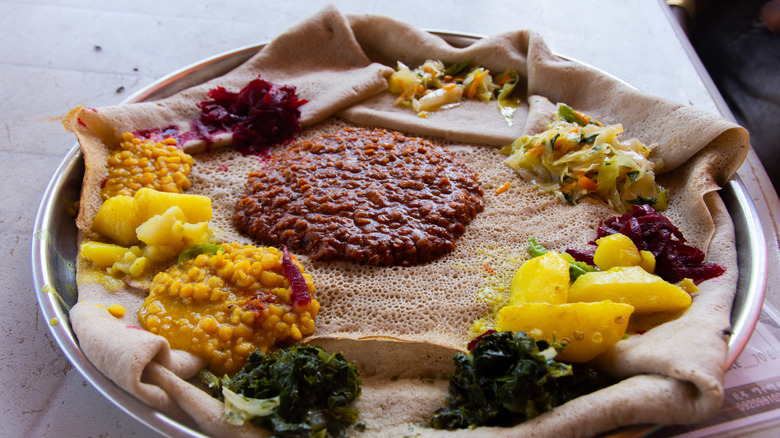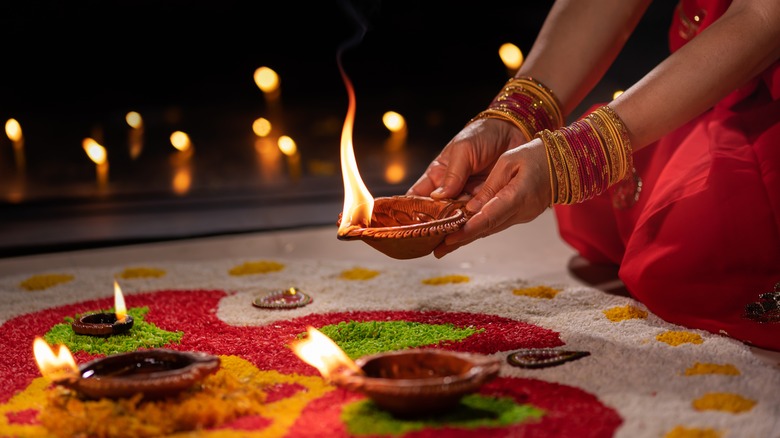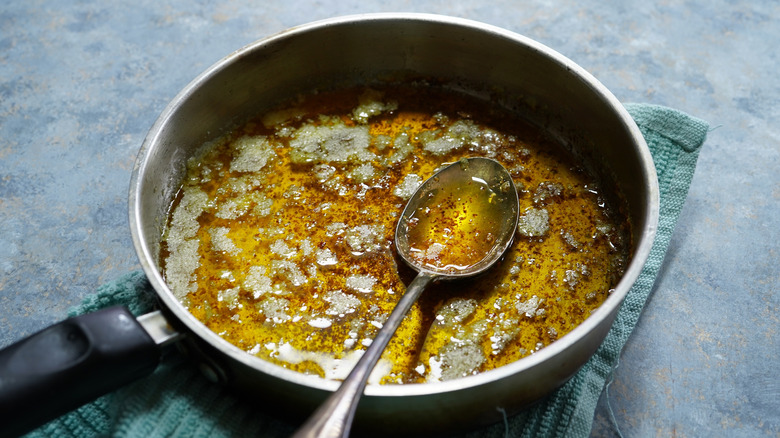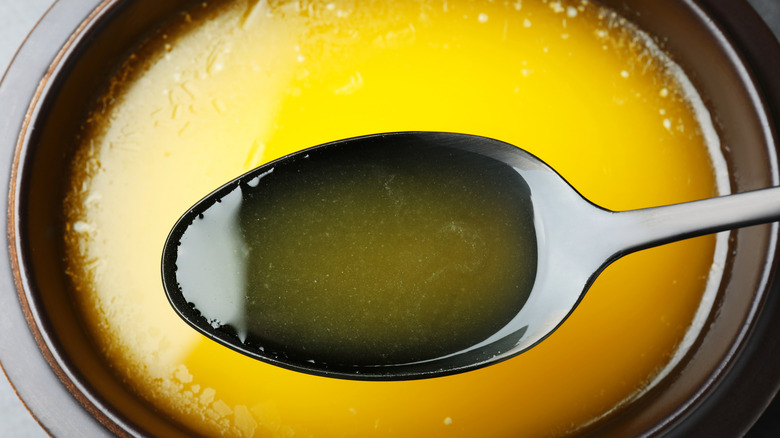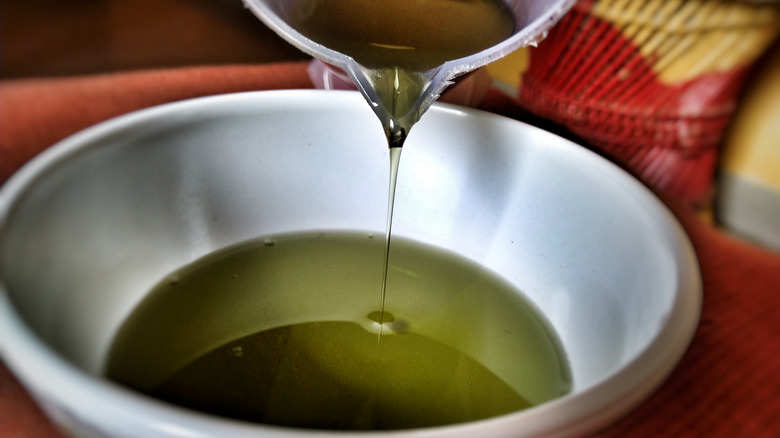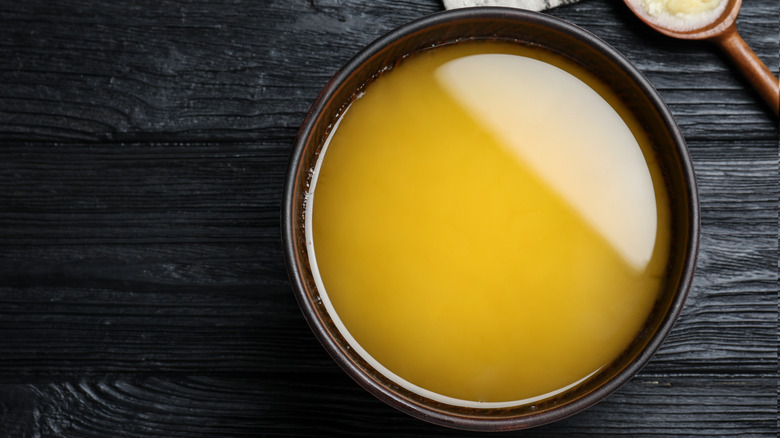The Ultimate Guide To Ghee
A properly made Indian curry, whether cooked in a restaurant or at home, will nearly always have a distinct and easily recognizable fragrance: warm, wholesome, and cozy, hiding beneath the sweet aroma of spices and the earthy scents of onions and garlic. That fragrance is the smell of hot ghee, and it's an essential part of the many cuisines of South Asia. Per Britannica, ghee is so important in the Indian subcontinent that the only foodstuffs more widely eaten there are rice and wheat. Ghee, as in a form of clarified butter, is commonly made from either buffalo milk or cow milk, the latter of which is not only a valued cooking ingredient but also holds important religious significance among Hindus.
Ghee has seen renewed popularity, spurred by what the BBC calls a "return-to-basics movement in India." Food author Kalyan Karmakar told BBC that this revolves around people being "more mindful about their food" and favoring a slower, homemade pace. Butter has been maligned for being rich in saturated fats and ghee contains slightly higher amounts, according to Healthline.
Despite that, India has once again given ghee a place in c. After all, people have been making and using ghee in South Asia for thousands of years. Some have even called it "liquid gold." As such a time-honored cooking ingredient, there's a lot to know about this distinctly cultural and culinary staple.
The history of ghee
Like with all the oldest parts of human culture, it's hard to say exactly when people first started making and using ghee. Spiceography notes that it's widely believed to have been invented around 1800 B.C., but it could have been first created as early as 6000 B.C. Historians widely believe it was made for its impressive shelf stability, says Spiceography. In the warm climate of South Asia, regular butter quickly goes rancid, but the site claims well-made ghee can stay edible for years.
Ghee would go on to become so popular across the Indian Subcontinent that it gained religious significance. Forbes India explains that ghee was considered worthy of the gods themselves. It's even mentioned in ancient Sanskrit literature: The Rig Veda, one of the oldest known Indo-European texts, speaks about butter under the Sanskrit name of ghrita.
The Washington Post reports ghee even holds a place in Hindu mythology as a divine creation by the god Prajapati, lord of the creatures. Where Ancient Greek mythology speaks of nectar and ambrosia as the food of the gods, the article explains Hinduism enshrines ghee in this role with traditional Vedic cuisine considering foods cooked with ghee (pucca khana) superior to all others (kacha khana). Scarce wonder it's been held in such high regard in South Asia since ancient times.
Cooking with ghee
Ghee is an ideal cooking fat, particularly for frying, because it has an exceptionally high smoke point. The smoke point when cooking with ghee is a blisteringly hot 485 degrees. This is not only well above most other commonly available cooking oils, but it's above even the highest frying temperature of around 450 degrees, per The Chopping Block. By comparison, regular butter will start to smoke and burn above around 350 degrees. In other words, even on high heat, cooking with ghee won't fill your kitchen with smoke, even with the hottest frying pan.
While ghee can be used as a cooking fat in any kind of cuisine, it's particularly well suited to the complex flavors of Indian cooking with all of its fragrant spices. Preparing South Asian cuisine usually starts with the spices being tempered by frying them in a hot pan. Ghee is perfect for this, filling the air with mouthwatering aromas even when the actual cooking has only just begun. As The Hindu mentions, this scent of hot ghee and sautéed spices is a nostalgia-inducing aroma for lots of people from South Asia because tempering spices this way is an essential step in preparing many authentic Indian recipes and a key part of bringing out their full flavor in the finished dish.
Wholesome rice dishes
The simplest way to use ghee in cooking is to make filling and flavorful rice dishes. As Swasthi's Recipes explains, ghee rice is favorite comfort food in South Indian homes. Not dissimilar to other rice dishes like Chinese fried rice or Spanish paella, ghee rice is simply fragrant spiced rice with a few other added ingredients like cashews and onions. Being a one-pot meal, it's easy to prepare and doesn't need much cleaning up afterward. You can even make this in an instant pot to make it even simpler. Very convenient if you're too busy or tired to prepare anything more involved. While it's a classic homemade meal, Swasthi's Recipes says it's popular enough that it can also be found on the table on special occasions like weddings.
While ghee rice is blissfully easy, other rice dishes also rely on ghee both for flavor and to give the cooked rice a nice glossy sheen. One good example is pilau rice (also known as pulao or pilaf). Anyone familiar with South Asian and Indian cuisine will likely have tried this fragrant spiced rice dish before. Usually brightly colored with ingredients like turmeric, it can be served as a filling side dish or enjoyed as a meal in itself.
Fragrant curries
The characteristic aroma of any good Indian curry will carry the sweet, warm fragrance of ghee. And South Asia is home to a huge variety of curries, which can vary a lot depending on their location. From an outside perspective, it may be easy to think of all Indian food as being very similar, but the cuisines from the different regions of India are quite distinct from each other, as Caleidoscope explains in detail. Ghee, however, is essentially a universal ingredient for South Asian cooking, though there are dishes in which the flavor of ghee is particularly prominent. One well-known example is murgh makhani, better known in the English-speaking world as butter chicken. A rich and creamy dish, drenched with flavor, butter chicken can be made with regular butter, but will taste even better with the deeper flavors imparted by ghee.
Many Indian curries are served not with rice but with flatbread (although rice is still a popular side dish). Perhaps the best-known bread in South Asia is naan, although as Indian Express notes, naan likely originated in Persia. All the same, a freshly cooked fluffy naan is a traditional accompaniment to Indian curries, and hot naan is often also brushed with ghee for added flavor.
Indian sweets
India is also home to a variety of sweet treats. Colorful and fragrant, Indian sweets are notorious for being both extremely sweet and incredibly moreish, and a plate of them seldom lasts long. Just as butter is essential to making fudge, ghee is a central ingredient of the most beloved Indian sweets. One firm favorite is ladoo (sometimes spelled laddu or laddoo), particularly a variety called besan ladoo. Per Maharashtra Tourism, these rounded treats come in a number of different variations, with besan ladoo made from gram flour and ghee, cooked to give a beautifully rich, nutty fragrance and a crumbly texture. The ladoo, as Indian Express notes, is enjoyed everywhere in India, but is a particularly common sight during festivals like Diwali.
Another luxurious sweet made with ghee is Mysore Pak, a fudgy, melt-in-the-mouth sweet. This particular delicacy has a kingly past. The story, according to the Times of India, goes that this dish was created specifically for Maharaja Krishnaraja Wodeyar as part of a royal lunch in the city of Mysore back in the early 20th century. Incorporating the exquisite aromas of rose water and fine honey and approved by the Maharaja himself, the chef made a snap decision to name the dessert after his home city. Soft, crumbly, and aromatic, anyone who enjoys a piece of good quality fudge will no doubt enjoy this quintessentially South Indian delight.
Ghee in the cuisines of Africa
Ghee may be a beloved and central part of Indian cooking, but it can also be found in cuisines across Africa. According to The African Gourmet, it's used frequently in Maghrebi countries like Algeria and Morocco, as well as sub-Saharan countries like South Africa. African cultures often have their own traditional versions of ghee, as noted in a study published by the Italian Journal of Animal Science, with a number of variants like Egyptian semna and Ugandan samuli.
Some African versions of ghee are also prepared differently to Indian ghee, and may also include other ingredients like spices. One prominent example is niter kibbeh, which gives a characteristic aroma and richness to Ethiopian cuisine. As African Food Network describes, niter kibbeh shares the high smoke point and long shelf life of ghee but is infused with the flavors of herbs and spices during preparation. Two of its key ingredients are besobela and kosseret, a couple of uniquely Ethiopian herbs which, sadly, may be difficult to find elsewhere in the world, according to African Food Network. Even without these, niter kibbeh still carries the rich flavors of cardamom, cinnamon, and black peppercorns, among other spices. The densely flavored stews and curries that Ethiopia is famous for wouldn't taste quite the same without it.
Hinduism and sacred ghee
Among Hindus, ghee is more than simply a cooking ingredient. It's also a vital part of their religion. Rituals and ceremonies are central to Hinduism, and asking the deities for blessings is a regular practice. According to the BBC, as the final extract of milk, Hindus consider ghee to be more pure than any other food in the world, making it the finest offering that can be made to the gods. The cow is a sacred animal in Hinduism, which linked to Krishna, one of the most important of the Hindu deities. As such, the ghee which is so central to Hinduism is specifically made from the milk of grass-fed cows.
Eshwar Bhakti explains that this is the truly divine form of ghee used during ceremonies, including marriages and funerals, and it's an auspicious act to pour ghee into fire. During festivals in India, ghee is used as fuel in lamps, which are lit for good fortune. These ghee lamps are famously associated with Diwali, the widely celebrated Hindu festival of lights, and also known as Deepavali. Eswar Bhakti says the lighting of ghee lamps is a central part of Diwali, signifying illumination and serving as an invitation for Kubera, the god of wealth, who will bring prosperity and wisdom to any home he visits. Ghee-rich dishes, such as a Sooji Halwa recipe, are also important during Diwali celebrations.
How ghee is made
Traditionally, ghee is made at home. The Hindu explains the traditional method starts with fresh, unpasteurized milk that is boiled, cultured into yogurt, churned, and then heated to separate the milk solids. While the ghee is prepared, the milk solids sink to the bottom and start to brown and caramelize, which is part of what gives ghee its distinctive flavor and aroma. As the BBC says, churning is now often done with a blender. The method also produces buttermilk, which is a valuable cooking ingredient in its own right.
An easier homemade ghee recipe starts with regular butter and clarifying it by heating in much the same way. The key is to evaporate away any excess water, and the final ghee should be a bright sunshine-yellow color. A small batch of ghee doesn't take long to prepare on a stovetop, though care must be taken to prevent burning.
Of course, ghee can easily be bought (even A2 ghee is popping up in stores) and shouldn't be hard to find — and not just places selling South Asian or North African groceries. Homemade ghee, however, is widely considered to have a better flavor. According to Goya, this is because the industrial manufacture of ghee requires standardization. This means the same flavor can be produced consistently, but this comes at the cost of the more subtle notes, which make homemade ghee so flavorful.
Ghee, butter, and clarified butter
Some people will tell you that ghee and clarified butter are the same thing. While it's true that the two can be used interchangeably in cooking, there are some noteworthy differences. The main one is the flavor of ghee, which is very different to most clarified butters. The main source of ghee's unique flavor comes from milk solids which caramelize during preparation. This method also helps develop the bright sunshine yellow color which ghee is known for. As The Hindu notes the milk solids (called kasadu) aren't removed until after the ghee is made.
Masterclass says the kind of clarified butter used in western cooking originates in France, where it contributes to the buttery flavor which French cuisine is well known for. This taste, however, is very different from the taste of ghee used in South Asian gastronomy. All the same, they do still share many similarities. Both have a long shelf life, a high smoke point, and are easily digestible. In any recipe which calls for clarified butter, it's entirely possible to substitute ghee and vice versa. The difference in flavor, of course, is purely a matter of taste.
Ghee and health
Saturated fats have a poor reputation where health goes, and with good reason. According to Medline Plus, saturated fats and trans fats, when consumed in excess, can cause a buildup of cholesterol in blood vessels, leading to health concerns like heart disease. Ghee is rich in saturated fats, so it's best consumed in moderation. However, ghee does also have a few things going for it.
WebMD notes that ghee is rich in monounsaturated omega-3 oils, which can actually support good cardiovascular health. This includes the fact that, as part of a balanced diet, WebMD finds that ghee can help to reduce cholesterol levels in the body. Ghee is an excellent source of nutrition: It contains vitamin A, which helps eyesight and the immune system, as well as the antioxidant vitamin E, and vitamin K, which helps promote healthy bones. Fittingly for a sunshine-yellow food, it's also a good source of vitamin D during the dark winter months.
Ghee has long been seen as important for health. It's long been used in traditional herbal medicines in South Asia, notably, as a salve to treat burns. One way or another, ghee has benefits other cooking fats just don't.
Ghee and dairy intolerance
While ghee is most definitely a dairy product, it may still be suitable for some people with dairy intolerances. It's best to be careful, however, as some of the claims circulating may not be entirely accurate — ghee is not an intolerance-free card. The reality is slightly more complicated. Cleveland Clinic notes that it contains low levels of lactose and casein, meaning it can be a good choice for people with lactose intolerance. While it's worth noting that the same is true of regular butter too, some people may find ghee easier on the digestive system. For those with mild intolerances, or those who're choosing a lactose-free and casein-free diet, this can make ghee a promising option to consider.
However, people with milk allergies should still avoid ghee, especially if those allergies are severe. As Live Strong explains, while it may be free from milk solids, it can still cause an allergic reaction from lingering milk proteins. The safest option for anyone with dairy allergies is still to steer clear of ghee and choose a non-dairy milk alternative.
